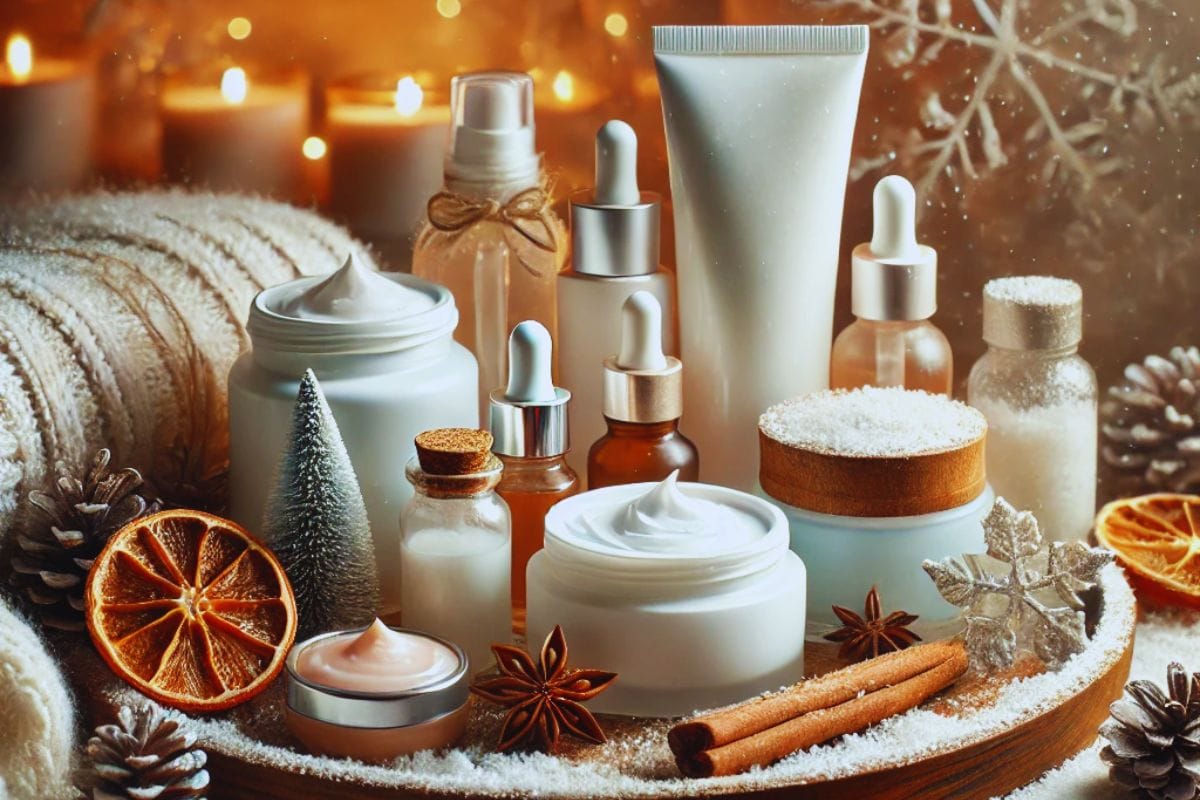Winter Skincare Routine to Combat Dry and Cold Weather

As winter settles in, our skin undergoes a subtle transformation, reacting to the dramatic drop in temperature and humidity levels. While the colder months are a welcome relief from the intense heat, they introduce unique challenges for maintaining skin health. Unlike other seasons, winter brings a significant reduction in moisture levels, both outdoors and indoors.
As the air loses its humidity, so does our skin, which often leads to dryness, flakiness, and a range of irritations. Coupled with the effects of indoor heating, which further strips the air (and skin) of moisture, winter conditions demand a different approach to skincare.
The cold air and wind outside also play a role in breaking down our skin's natural barrier, making it harder to retain hydration and leaving it more vulnerable to redness and sensitivity. These seasonal effects make it essential to adjust our skincare routines, incorporating richer and more protective products that address winter-specific needs. With the right changes, your skin can stay hydrated, resilient, and radiant throughout the colder months.
Hydration Begins from Within

Maintaining adequate hydration is crucial for skin health, even during colder months when the urge to drink water diminishes. In winter, the combination of low humidity and indoor heating can lead to increased transepidermal water loss, resulting in dry, flaky skin.
Consuming sufficient water helps maintain the skin's moisture balance, supporting its barrier function and overall appearance. It's important to recognize that the body's hydration needs remain consistent year-round, despite reduced thirst signals in cooler weather.
Incorporating herbal teas and water-rich foods into your diet can further enhance skin hydration. Herbal teas, such as chamomile or rooibos, not only contribute to daily fluid intake but also provide antioxidants that support skin health. Fruits and vegetables with high water content, like cucumbers, watermelons, oranges, and strawberries, offer hydration along with essential vitamins and minerals.
For instance, watermelon is composed of about 92% water and provides vitamins A and C, which are beneficial for skin health. Including these hydrating foods and beverages in your daily routine can help maintain skin moisture levels, promoting a healthy and radiant complexion throughout the winter season.
How Can You Identify Your Skin Type for Tailored Winter Care?
Understanding your skin type is essential for selecting appropriate winter skincare products and preventing unnecessary irritation. Skin types are generally categorized as normal, dry, oily, combination, or sensitive, each with distinct characteristics and care requirements.
For instance, dry skin may require richer, more emollient moisturizers to combat winter-induced dehydration, while oily skin might benefit from lightweight, non-comedogenic formulations to prevent clogged pores. Sensitive skin necessitates gentle, fragrance-free products to minimize irritation. Tailoring your skincare routine to your specific skin type ensures optimal hydration and protection during the colder months.
Identifying your skin type involves observing your skin's behavior and characteristics. One common method is the "bare-faced test": cleanse your face with a gentle cleanser, pat dry, and leave it without applying any products for about an hour. After this period, assess your skin:
- Normal Skin: Feels comfortable, not too oily or dry, with minimal imperfections.
- Dry Skin: Feels tight or rough, may have flaky areas, and appears dull.
- Oily Skin: Appears shiny, especially in the T-zone (forehead, nose, chin), with visible pores.
- Combination Skin: Exhibits oiliness in the T-zone and dryness on the cheeks.
- Sensitive Skin: Prone to redness, itching, or burning sensations, especially after using certain products.
Another approach is the "blotting sheet test", gently press a blotting paper on different areas of your face after an hour of cleansing. If the sheet picks up little to no oil, you likely have dry skin; if it shows oil from the T-zone, you have combination skin; if it collects oil from all areas, you have oily skin.
Ingredients to Look for in Winter Skincare
Moisturizing Ingredients
- Humectants: These substances attract water from the environment and deeper skin layers into the outermost layer of the skin, enhancing hydration.
- Hyaluronic acid is a naturally occurring molecule capable of holding up to 1,000 times its weight in water, making it highly effective for skin hydration.
- Glycerin is a potent humectant that draws moisture into the skin, improving hydration and skin barrier function.
- Emollients: These ingredients fill in the gaps between skin cells, smoothing and softening the skin's surface.
- Squalane is a stable, saturated hydrocarbon that mimics the skin's natural oils, providing lightweight moisture without clogging pores.
- Rich in fatty acids and vitamins, shea butter nourishes and conditions the skin, enhancing its barrier function.
- Occlusives: These agents form a protective layer on the skin's surface, preventing moisture loss.
- Petrolatum is an effective occlusive that locks in moisture, making it beneficial for extremely dry skin areas.
Soothing Ingredients
- Known for its anti-inflammatory and healing properties, aloe vera soothes and hydrates the skin.
- Oatmeal (Colloidal Oatmeal) contains avenanthramides, which have anti-inflammatory and antioxidant effects, making it effective in relieving dry, itchy skin.
- Rich in flavonoids and essential oils, chamomile has calming and anti-inflammatory properties, beneficial for sensitive or irritated skin.
Antioxidants
- Vitamin C is a potent antioxidant that neutralizes free radicals, supports collagen production, and brightens the skin.
- Vitamin E works synergistically with vitamin C to protect the skin from oxidative stress and improve moisture retention.
Sun Protection Matters Even in Winter
It's a common misconception that the sun's ultraviolet (UV) rays are less harmful during winter months or on overcast days. In reality, UV radiation remains a significant concern year-round. Cloud cover can reduce the amount of UV radiation reaching the Earth's surface, but it doesn't eliminate it entirely. In fact, up to 80% of UV rays can penetrate through clouds, leading to potential skin damage even on seemingly dull days.
Integrating sun protection into your winter skincare regimen can be seamless and comfortable. Opt for lightweight, broad-spectrum sunscreens with an SPF of 30 or higher that can be easily layered over your moisturizer without feeling heavy or greasy. Many modern formulations are designed to provide effective protection while maintaining a pleasant texture, making daily application more appealing. Alternatively, consider using moisturizers that contain built-in SPF, which can simplify your routine by combining hydration and sun protection in one step.
Gentle Winter Skincare Practices for Lasting Hydration and Protection
During winter, maintaining your skin's moisture is essential to prevent dryness and irritation. Choosing the right cleanser is a crucial first step, as traditional foaming cleansers and harsh soaps can strip away natural oils, making your skin even more vulnerable to the effects of cold weather. Instead, opt for hydrating cleansers that include ingredients like glycerin, hyaluronic acid, and ceramides, which help cleanse without disrupting moisture balance. Using lukewarm water rather than hot helps protect your skin’s natural oils, and limiting cleansing to once a day, especially if your skin feels tight, can further prevent unnecessary dryness.
Winter can also bring increased sensitivity and redness, which can be calmed by incorporating products rich in ceramides, chamomile, and oatmeal. These ingredients soothe the skin, reduce inflammation, and strengthen the barrier against environmental stressors. Exfoliation, while beneficial for removing dead cells and promoting a brighter complexion, should be done gently in winter. Opt for mild exfoliants like lactic acid or enzyme-based products, and limit exfoliating to once or twice a week to avoid over-stripping the skin.
Dry lips are another common winter issue, as the delicate skin on the lips quickly loses moisture in colder weather. Using a lip balm with occlusive ingredients like petrolatum or beeswax can create a protective barrier to lock in hydration. Frequent application, especially before going outdoors, keeps lips soft and comfortable. Refrain from licking your lips, as this can worsen dryness; instead, rely on a hydrating balm to maintain moisture.
Revamping Body Care for Winter
As temperatures drop, the skin on our body, particularly on areas like arms, legs, hands, and feet, becomes more vulnerable to dryness. Winter air has low humidity, which depletes moisture from the skin, making it essential to adjust body care routines for deeper hydration and protection.
Body Moisturizers and Lotions
Switching to thicker body creams and butters is a key step in winter body care. Thicker formulations with emollients, such as shea butter and cocoa butter, help lock in moisture and strengthen the skin’s barrier. Humectants like glycerin and hyaluronic acid draw water into the skin, enhancing hydration. Opt for body lotions with these ingredients, applying them after a shower when the skin is still slightly damp to maximize moisture retention.
Hand and Foot Care
Hands and feet often experience the harshest dryness in winter, as they’re frequently exposed to cold air and washing. Investing in thicker hand creams and foot balms can provide intensive care for these areas. Look for hand creams with occlusives like petrolatum or beeswax to form a protective layer, sealing in moisture. For feet, choose balms rich in urea or lactic acid, which soften calloused skin and promote hydration. Applying a thick layer before bed and wearing cotton gloves or socks can enhance absorption and keep hands and feet supple throughout the season.
Night-Time Routine for Deep Repair
Nighttime is an optimal period for skin repair and hydration, especially during the winter months when skin faces increased dryness. As we sleep, our skin naturally goes through a restorative process, making it the perfect time to use thicker, nutrient-dense products that support and enhance this repair cycle.
Night Creams and Sleeping Masks
Switching to a thicker night cream or sleeping mask during winter can make a significant difference in skin hydration. These products are typically formulated with rich emollients and occlusives, which help lock in moisture, creating a protective barrier that prevents overnight moisture loss. Night creams with ingredients like ceramides, shea butter, and squalane reinforce the skin’s natural barrier, reducing the likelihood of dryness and irritation.
Sleeping masks, designed to be applied as the last step, offer even more intensive hydration and are left on overnight, allowing ingredients to penetrate deeply. The result is softer, more resilient skin by morning, better equipped to handle cold and dry conditions.
Winter-Friendly Overnight Tips
Beyond skincare products, creating a moisture-friendly environment is also important for overnight skin health. Using a humidifier in the bedroom adds moisture to the air, counteracting the dryness caused by indoor heating. This extra humidity helps skin retain its natural hydration levels throughout the night, preventing dryness.
Another helpful tip is to switch to silk or satin pillowcases, which are gentler on the skin than cotton. These fabrics reduce friction, helping to prevent irritation and moisture loss from the skin. Together, these simple adjustments can enhance the effectiveness of your winter skincare routine, leaving your skin hydrated and rejuvenated even in the driest months.
Winter calls for a little extra care, reminding us to adapt and protect our skin against the season’s chill. As you make these small changes to your routine, remember that these mindful steps help keep your skin strong and healthy all season long. Embrace winter as a time to care for yourself in simple yet meaningful ways, letting each step in your routine bring a bit of comfort and calm to colder days.
